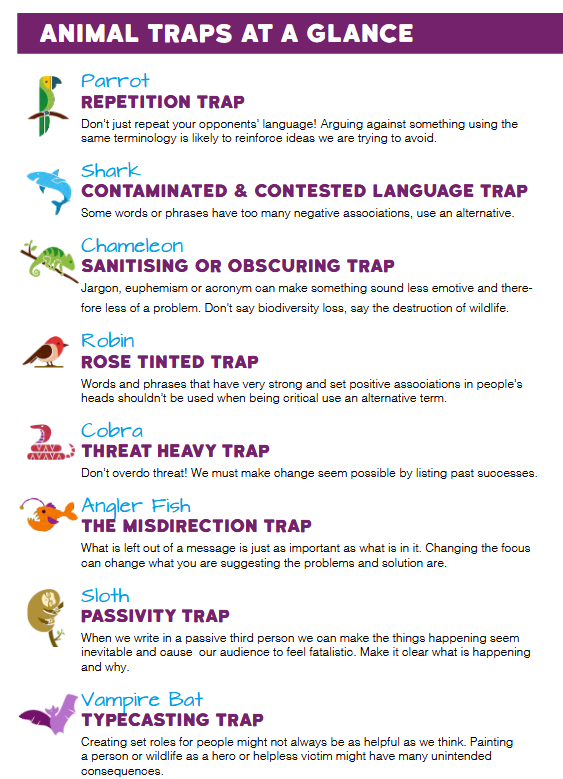When Everything is Urgent, Nothing is Urgent🧠 Brain STREAM 3️⃣1️⃣
Communicating biodiversity loss without using some aspect of 'death' in the headline.

Thanks to all the recent subscribers to Brain STREAM🧠 from Knowledge Ecology! We're now on issue 31! This may not seem high - at least it doesn't to me - but 31 feels like a significant milestone for me to reflect and think about where I've come.

Today I present you with a challenge: how do you write about biodiversity loss without using the words 'death' or 'destruction'? A bit tricky isn’t it? Yet I feel moving away from such words is what environmental communication needs right now. In this 31st issue of Brain STREAM, let's explore.
As I've been scrolling through my news feed in the last few weeks, I've been paying more attention to how the headlines make me feel. And the answer is: a bit meh. Everything is ‘dying’, ‘collapsing’, or facing ‘extinction’. Don't get me wrong - these issues are real and serious. But there's a couple of things about this relentless 'drumbeat of death-focused, doom' that has been irking me.
Firstly, is it just me? Perhaps there’s some kind of underlying confirmation bias? And secondly, assuming there isn’t, I wondered is there a better way we can talk about biodiversity loss? One that communicates reality and inspires positive action? Think of these a little like two hypotheses I want to explore.
The next step is to gather some data.

Lets have a looksie to see how much 'death' is used
The data gathering I did was not rigorous, just a looksie. The kind of thing we might do before doing a big, expensive study. It's the - 'am I onto something?', stage.
The Guardian
I started with the Guardian because this is where most of the 'traditional news' articles come from on my news feed. I love how they're free to read, so naturally I read a lot more of what they write about…
Every day my Google feed serves up at least one new Guardian article about climate-related death, dying, or destruction. I see reports about poor tree regeneration across the UK, honeybee colonies collapsing, insect numbers plummeting in seemingly pristine forests, and contamination of nature reserves, lakes and rivers.
Everything is labelled 'a crisis', 'an emergency', or 'urgent'. When every headline includes death, dying, or destruction, the words lose their power to communicate true urgency.
I counted the headlines in The Guardian's extinction section where they gather all articles related to biodiversity loss.
Out of 40+ articles displayed, roughly 50% include some variation of "dead", "killer", "strangled", "died", "death", "die-offs", or "poison" in the title. There's even one positive article where they've managed to squeeze "death" into the headline! 🤦
So, a great start - there’s something going on - but what about other newspapers?
The Times
The Times actually fared much better. Amongst a similar amount of articles in their 'environment' section, death and dying hardly featured at all.
Instead they use more words like 'saving', 'heat' and ‘water’. There's more on political, technology and money-related issues as they relate to the environment.
I headed back to the Guardian. I wondered if they had a wider 'environment' section and which approach would be used. Turns out they align more closely with the Time on this one. In this website section, the Guardian shares more positive outcome stories, wider politics and climate issues. Interesting:
- 'It's spectacular': volunteer Dorset divers see summer of surging seahorses
- 'Intrinsically connected': how human neurodiversity could help save nature
I also checked out The Herald, Telegraph, Daily Mail and The Independent. These newspapers don't have 'environment' sections, perhaps reflecting this aspect of news is much lower on their agendas. I also found this incredibly curious. I know which newspapers I won’t buy in future.
But to summarise we've learnt two things so far. When talking about the environment generally, there seems to be a better balance of reality and action. But start talking about 'extinction' and biodiversity loss, and the language seems to change. It could be a Guardian editor issue. Or language use might be reflecting an underlying agenda of the writing team - not a bad agenda - but could it have the opposite effect to what we want? Those who use stronger language might be more frustrated, more keen and more willing to take action.
There's a note to be made here about the information I am being fed from the 'almighty algorithm'. Perhaps here is evidence of a 'filter bubble' which is when algorithms curate our social media feed to show us content similar to what we've previously engaged with, trapping us in a bubble of information that confirms our existing beliefs.
The underlying psychology here is confirmation bias which I alluded to in the first section. This is our natural tendency to seek out, interpret, and remember information that confirms what we already believe while avoiding or dismissing information that challenges those beliefs.
I must subconsciously seek out 'death' and biodiversity… rather than more positive stories…
Let's consider what happens when everything is important and urgent and deathly.

Mention death, and we think about death
Crisis language creates what researchers call "issue fatigue". People become emotionally exhausted by endless exposure to problems they feel powerless to solve. It's the same mechanism behind compassion fatigue in healthcare or donor fatigue in charity work.
I get why journalists use death language. It grabs attention, and these issues genuinely are serious. But when everything is framed as urgent, nothing feels urgent anymore. When I read my daily environmental news, I don't feel energised to make a difference. I feel a bit... well, dead inside. And that's exactly what we don't want.
However, there is still an issue here. Whilst we need to communicate the scale of biodiversity challenges, overuse of death-laden headlines becomes numbing rather than motivating.
Scaling our writing helps situate it
So how do we write about serious environmental issues without defaulting to death language? I think the answer lies in scaling our words to match reality.
I like to think about biodiversity loss not as a cliff-edge, but as a slippery slope - one we can recover from, but where the faster we slide, the harder it becomes to get back up again and the more damage occurs along the way. I feel certain politicians might be greasing the slide, but I digress …
For any environmental story, we can ask ourselves a few key questions to help frame its context:
Time-scale: Can this be reversed in weeks, months, years, or is it permanent? Geographic scale: Is this happening locally or globally? Scientific certainty: Is this preliminary data, peer-reviewed research, or scientific consensus? Recovery potential: How likely is natural or assisted recovery?
Then we can scale our language accordingly, for example how certain we are and the temporal implications can help define true 'urgency':
For scientific certainty:
- Early data suggests, studies indicate (preliminary)
- Research shows, peer-reviewed studies find (established)
- Multiple studies demonstrate, scientific consensus shows (well-established)
For urgency:
- Changes, fluctuations, variations (low urgency)
- Declining, reducing, facing challenges (medium urgency)
- Collapsing, disappearing, on the brink (high urgency)
- Extinct, eliminated, gone (crisis level)
These are just suggestions and you may want to develop your own way of scaling what you talk about. This is not only relevant to biodiversity and climate-related issues, but applies to anything you write about. Developing our own scales can also help us to interpret the things we read, because they encourage us to ask questions of what it is the writer is really trying to say i.e. the evidence they don’t provide is as telling as the evidence they do.
Let’s try this scaling approach out
Now let's try this in practice. Though first an important caveat - I am not a seasoned professional headline writer!
Take the recent Guardian headline: "In some UK woodlands, every young tree has died. What's going wrong?"
Using my scaling approach, I might ask: What's the time-scale here? Well, the Woodland Trust reported 2020 was a mast year when trees produce vast amounts of seeds, most of which naturally don't survive. Many seedlings would be 2-4 years old during this study period - natural die-off is expected. To this extent I would need to see the wider trends. I need to know the answer to the question, was 2020 a phenomenal mast year?
What's the scientific certainty? The research hadn't gone through peer review when the article was published, so expert scientists haven’t cast their beady eyes over it yet. The authors do report similar effects in other woodlands across the UK suggesting some stronger evidence, but science has a process and that process is not yet complete.
A scaled version might read: "Woodland regeneration across the UK shows concerning patterns as young trees struggle to establish." This grabs my attention, but is better matched to the certainty, reversibility and the bits 'I don't yet know' of the situation.
Or consider other more general environmental headlines:
- Instead of "Species facing extinction crisis" → "Species populations declining rapidly" or "In x years time, we may no longer see (animal) unless (cause) is stopped"
- Instead of "Ecosystem collapse threatens wildlife" → "Climate-induced ecosystem changes put wildlife at risk" or "(Cause) means (organism) can no longer/struggles to (effect)"
- Instead of "Pollution killing marine life" → "Marine life no longer able to tolerate (source) pollution levels" or "(Solution) will keep marine life (what we want)"
The information is the same, but the language creates space for solutions, optimism and realism rather than just despair. We need to take more inspiration from environmental communication more generally and apply it to biodiversity loss.
A framework I found useful: the Animal Traps Framework
Conservation Optimism has developed a ‘positive communication toolkit’ pdf guide to help deal with communication challenges like I have identified here. They share a series of ‘animal traps’ we can slip into when we write about challenging issues like biodiversity.
Each trap represents a different way our language can backfire when we're trying to communicate about serious issues.

Here's some examples:
- The Shark (contaminated & contested language trap) warns us that some words carry too many negative associations. Perhaps "crisis" and "emergency" have become so overused they've lost their power to motivate.
- The Cobra (threat heavy trap) reminds us not to overwhelm people with threats without showing them what's possible.
- The Sloth (passivity trap) can be sneaky - when we write in passive voice about environmental issues, we make change seem inevitable rather than something people can influence.
- The Angler Fish (misdirection trap) reminds us that what we leave out matters as much as what we include which I mentioned earlier.
Better biodiversity communication has a few simple requirements
So what does environmental writing look like when it avoids the death trap? Well although it starts in the headline, it continues into the text. The first paragraph or two being particularly important. Here are some things I've noticed in communications that motivate action:
- Explaining what normal variation looks like helps readers understand when something is genuinely concerning. This should be done early on.
- Consider what action the reader can take right now to influence the outcome rather than just observe it. That is, be clear about the action.
- Be specific about the problem rather than 'all birds are doomed' change to '% of the top 10 song birds have declined by x%'
We want to both be clear about the issues but importantly communicate them in ways that inspire action. Because if we want people to care about biodiversity, we need them to feel capable of making a difference.
💡 Action Point: Try these techniques with your own writing. Pick a piece where you're communicating about a serious issue - environmental or otherwise. Run it through Conservation Optimism's animal traps guide. Are you falling into the shark's contaminated language trap or the cobra's threat-heavy approach? Could you rewrite your key points using my scaling framework? What would those headlines look like if you couldn't use any words related to death, crisis, or emergency? 💡
Naturally, I read a lot of scientific papers due to the fact academic writing has to be more measured and contextual by nature - we put opinions aside and look at the evidence. Though I do worry that this too is changing, with researchers feeling pressure to make their findings sound more dramatic to get attention.
More on that topic next time. 👇🏻
Make sure you get it next time; subscribe to 🧠 Brain STREAM and get our newsletters straight to you inbox.
And research papers aren’t accessible to everyone in a multitude of ways, so the traditional, and not-so-traditional media will continue to have an incredibly important role to play. And as scientists, we have a massive role to play too.
TLDR; choose your words wisely
We need better ways to communicate about serious biodiversity issues - ones that inform without us feeling depressed and motivate us to do something. The alternative is a world where people tune out the very information they need to make good decisions. I think we can write about biodiversity loss in ways that respect both our need to reverse biodiversity loss, and giving people the autonomy of choice in how to take action. We just need to choose our words more carefully.
I'm working on it.
Until next time nature brains,
Annette

🧪 Sharpen Your Skills
- Conservation Optimism’s Positive Communication Guide
🧫 Interesting Life Stuff
- For better or for worse, I’ve signed up to Ali Abdaal’s $1k challenge
⌛ In Case You Missed It
- Writing is Thinking - short Nature editorial piece
- Hybridisation as a tool to blend research specialisms and get your work to become greater than the sum of parts
- From the archives: If you are looking for further guidance in how to communicate a lot of science in a small space, look no further than "101 Business Ideas That Will Change the Way You Work" by Antonio E. Weiss which I review here.
Quote of the Week
“If I understood you, would I have this look on my face?”
Alan Alda
What I’m Reading
- Nudge by Richard Thaler and Cass Sunstein - how making incredibly small changes creates ripple effects down the line



